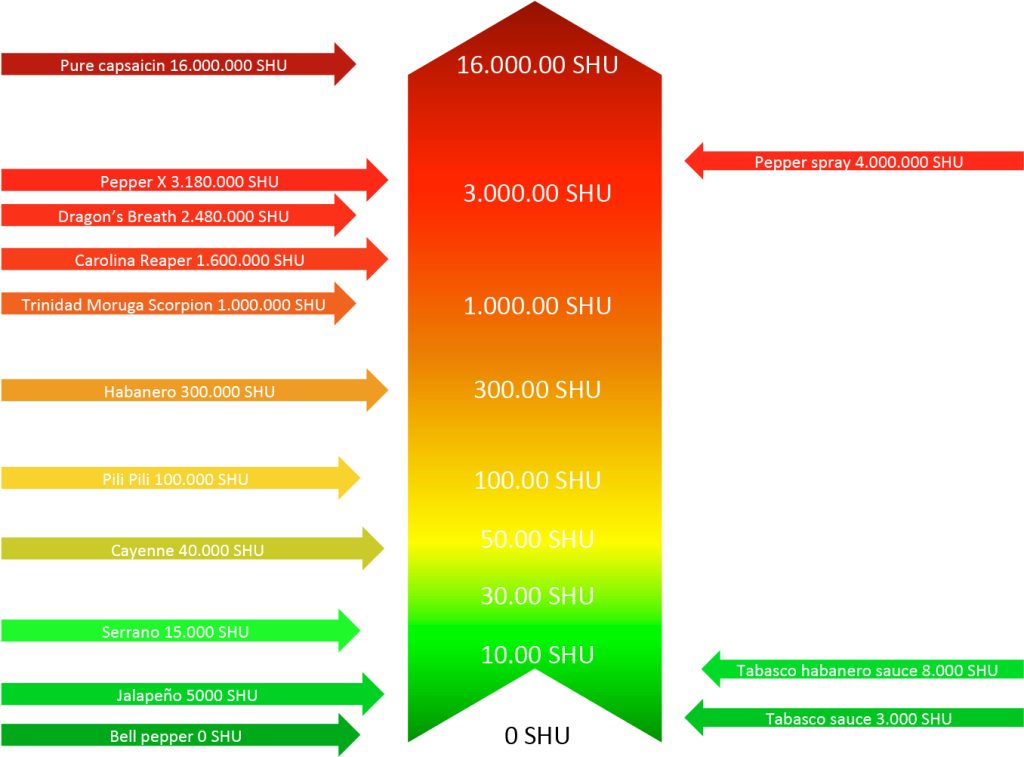Even those people that really are not into spicy food are probably aware of what chili peppers are. In biological terms, chili peppers are part of the Capsicum plant family, of which the most well known fruit is probably the bell pepper. When referring to chili peppers, people usually mean the spicy version which adds heat to many different dishes. Chili peppers originate from Mexico, but have travelled the world for many decades and have been a pivotal part in many different cuisines worldwide.
One of the most well-known chili peppers is probably the Jalapeño pepper, but despite it’s popularity it’s not really spicy enough with 3000-8000 SHU for real chili fanatics as myself. Okay, this is getting a bit technical already, but we’re talking about Scoville Heat Units (SHU) now. The Scoville scale is named after American pharmacist Wilbur Scoville, who came up with a test to measure the heat levels of peppers back in 1912 already. The Scoville scale is a linear scale that gives an indication of the concentration of the ingredients that give chili peppers their pungency or spicy heat. These ingredients are all in the capsaicinoid family, of which the most common one in chili peppers is capsaicin. A concentration of 1 part per million of capsaicin in a water solution is defined as 1.5 SHU. This implies that pure capsaicin clocks in at a staggering 15-16 million SHU. It is important to emphasise that the heat level is defined based on the capsaicin level in dried peppers, which can sometimes be a bit misleading. This implies that two peppers with a similar heat level can still give a different punch to your dish when they differ a lot in size. Obviously a larger pepper will add more capsaicin and hence result in a hotter dish. Note that many of the hotter peppers on the Scoville scale are less fleshy, which implies that despite their small form factor these can be insanely hot. Also note that for many peppers the heat level is given by a range in which that particular variety typically ends up. Heat levels can vary based on plant genetics, even within the same strain. The heat level also tends to go up as the pepper fruits ripen. Many peppers are already spicy several weeks before harvest, but they capsaicin level tends to rise to the maximum values during the final ripening stages of the fruits. An overview of some chili pepper varieties on the Scoville scale is shown below, along with a few comparison points on the right that can give an idea about the heat level of some of these peppers.

For those that are not really into chili peppers, it is useful to compare spice levels of chili peppers to some other foods that are considered spicy. Next to capsaicin there are several other molecules that can give a burning sensation to foods, but given the different composition, their level of spiciness cannot be measured on the Scoville scale. Nevertheless, it is possible to give some estimate values of where these foods would end up on the Scoville scale, which can at least give some feel for how spicy some of the chili peppers are.
| Food | Spicy molecule | pure SHU value | Typical content | SHU range |
|---|---|---|---|---|
| Chili pepper | Capsaicin | 16.000.000 SHU | 0.0 – 20% | 0 – 3.000.000 SHU |
| Black pepper | Piperine | 100.000 SHU | 5 – 10% | 5.000 – 10.000 SHU |
| Ginger | Gingerol | 60.000 SHU | 1 – 2% | 600 – 1200 SHU |
As can be seen from the table, commonly used black pepper is similar in pungency to jalapeño peppers (for equal dry volume that is), but at the same time is is about 30 times less strong than Habanero peppers, and even several hundreds of times less strong than the spiciest chili peppers in the world.
